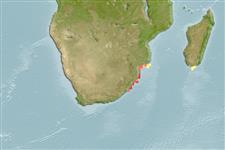Environment: milieu / climate zone / depth range / distribution range
Écologie
marin récifal; profondeur 20 - 50 m (Ref. 4319). Subtropical; 25°S - 33°S, 30°E - 46°E (Ref. 5222)
Western Indian Ocean: known only from Madagascar, Natal in South Africa, and southern Mozambique.
Taille / Poids / Âge
Maturity: Lm ? range ? - ? cm
Max length : 100.0 cm TL mâle / non sexé; (Ref. 4319); poids max. publié: 10.0 kg (Ref. 4319)
Épines dorsales (Total) : 11; Rayons mous dorsaux (Total) : 15 - 16; Épines anales: 3; Rayons mous anaux: 9. Distinguished by the following characteristics: body color dark reddish brown; head and body covered with small, irregular, close-set, dark red or reddish brown spots, pale interspaces forming irregular pale network pattern; 4 narrow, irregular, oblique, pale bars running down and forward on body; paired fins generally darker than body; body depth contained 3.1-3.5 times in SL; body width 1.7-2.0 times in depth; head length 2.3-2.4 times in SL; interorbital width 5.9-6.8 times in HL; concave interorbital area; rounded preopercle, finely serrate, shallow indentation just above angle; upper edge of operculum almost straight; inconspicuous opercular spines; posterior and anterior nostrils subequal; maxilla not reaching past eye; front of upper jaw with a pair of large, curved, fixed canines and a pair of similar but slightly smaller canines at front of lower jaw; lateral part of lower jaws with an outer row of 8-9 slightly smaller fixed canines and an inner row of smaller , more slender depressible teeth (Ref. 89707).
Appears to be a rare species, but it is of some importance to South African sport fishers along the northern coast of Natal. Coral reef-associated species inhabiting depths of 20-50 m (Ref. 89707). Feeds on fishes and invertebrates (Ref. 89707). Testes of a 61 cm SL specimen contained a central lumen and numerous 'brown bodies' along the lateral edges of the gonadal lamellae.
Life cycle and mating behavior
Maturité | Reproduction | Frai | Œufs | Fécondité | Larves
Heemstra, P.C. and J.E. Randall, 1993. FAO Species Catalogue. Vol. 16. Groupers of the world (family Serranidae, subfamily Epinephelinae). An annotated and illustrated catalogue of the grouper, rockcod, hind, coral grouper and lyretail species known to date. Rome: FAO. FAO Fish. Synop. 125(16):382 p. (Ref. 5222)
Statut dans la liste rouge de l'IUCN (Ref. 130435: Version 2024-1)
Menace pour l'homme
Harmless
Utilisations par l'homme
Pêcheries: pêcheries vivrières; pêche sportive: oui
Outils
Articles particuliers
Télécharger en XML
Sources Internet
Estimates based on models
Preferred temperature (Ref.
123201): 23.7 - 24.7, mean 24.2 °C (based on 4 cells).
Phylogenetic diversity index (Ref.
82804): PD
50 = 0.5000 [Uniqueness, from 0.5 = low to 2.0 = high].
Bayesian length-weight: a=0.01175 (0.00568 - 0.02430), b=3.04 (2.88 - 3.20), in cm total length, based on LWR estimates for this Genus-body shape (Ref.
93245).
Niveau trophique (Ref.
69278): 4.0 ±0.6 se; based on size and trophs of closest relatives
Résilience (Ref.
120179): Très faible, temps minimum de doublement de population supérieur à 14 ans (Preliminary K or Fecundity.).
Fishing Vulnerability (Ref.
59153): High vulnerability (60 of 100).
